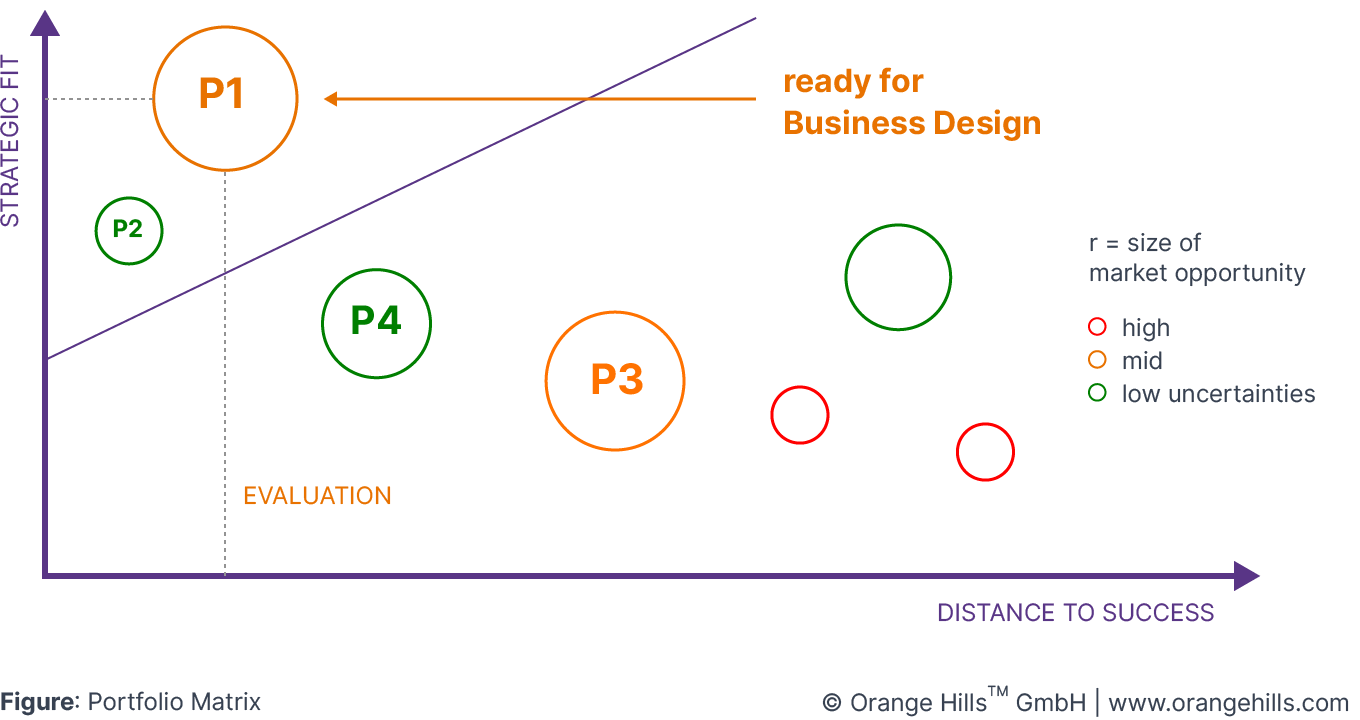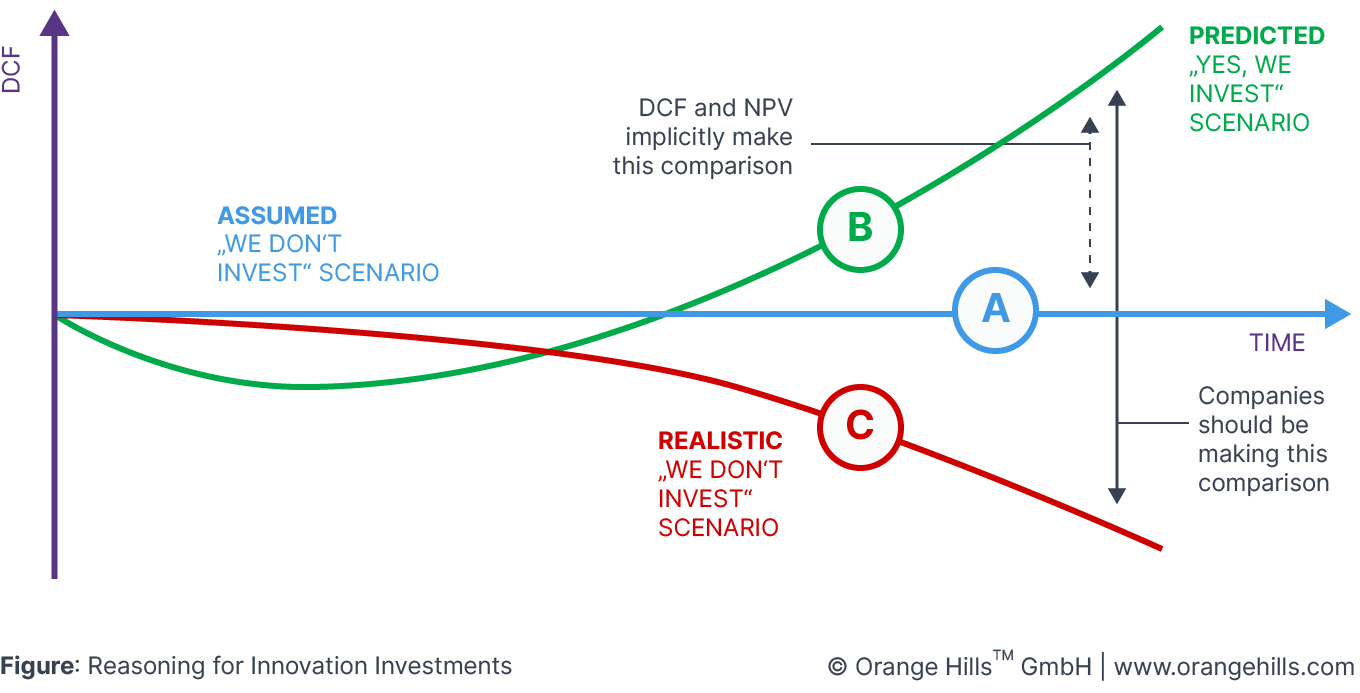Ideation
Translating inspiring insights from R&D into a portfolio of ideas for new products, services and business models is the focus of the ideation phase. We like to do this either in ideation workshops or lean scoping projects, which we describe in more detail in this article.

Sabine Schoen
Business Design Field Researcher

Florian Czak
Creative Business Designer
Content
1. Introduction
Based on profound research results, the creation of new ideas is the natural next steps. We usually do this with two key activities:
Ideation Workshops: Ideation Workshops can be a productive format to turn inspiring insights from Research into first rough ideas for new products, services, process improvements and even business models. Ultimately, the goal of the workshop is to fill or update our "Portfolio Matrix" with fresh input (see below), ready to be evaluated and prepared for the upcoming Business Design phase. Learn more about this format below.
Lean Scoping Projects: In some cases, existing ideas need some more additional research before we are able to judge them. If you are not able to formulate a precise Project Charter (without bullish*t), we often squeeze a so called "Lean Scoping Project" into the process, which serves the purpose of gathering as much relevant knowledge as needed to fill the gaps in order to define a proper Project Charter for your next Business Design project. Learn more about this format below.
2. Ideation Workshops
Ideation workshops are usually 4-6 hours physical or virtual sessions, in which a small group of selected experts (internal and external to the project) share a specific body of insights and quickly translate them into rough ideas / solutions. The participants of the ideation session should have an easy access to the topic due to their backgrounds and expertise, but at the same time they should bring in different perspectives. Yes, these workshops are about creativity pushing own mental boundaries to generate innovative output - it's about inspiring and being inspired. The aim is to create a multi-faceted spectrum of innovative ideas, where pragmatic feasibility is sometimes only a secondary consideration.
The most important input factor of such workshops is (beyond the people in the room) gathered insights from Research & Development we can digest systematically. Therefore, we love to formulate "How might we questions (HMW)" based on our research results as trigger questions for Ideation Workshops (read more about HMW questions here). The participants should be familiar with research results and/or were actively engaged in research activities. Sharing these insights combined with trigger questions (sometimes by the help of further Creativity Techniques) and an inspiring way of visualising ideas quickly is what we usually put on the agenda of Ideation Workshops. In most cases, we invite a designer to the workshop, who helps us visualise thoughts and ideas into tangible sketches and storylines - in realtime. We love that!
An Ideation Workshop usually needs a defined scope, which can be a "strategic search area" or a certain body of research in order to achieve something tangible. After the workshop, the generated ideas should be documented in a standardised "Idea Charter" format (see example above). You may have to cluster and synthesise some of them before. We also update the "Portfolio Matrix" with the new entries and try to evaluate ideas. If the evaluation of an idea is not possible we often continue with short "lean scoping projects".
3. Lean Scoping Projects
In some cases, you may find it difficult to define a clear and focused project scope for your next Business Design project. Why? Because it is not easy. Especially the definition of a customer and / or internal problem and (entrepreneurial) objectives that actually can be measured may give you a hard time. You need to have profound knowledge about your innovation area already before you even kick off a Business Design project. Innovation = something new = lack of knowledge? Well, profound knowledge about "something new" may sound like an oxymoron, but it is not. We just can't work with a briefing such as "We need a new business model based on data". This is why the Project Charter is so important at the start.
Therefore, we set up a very small group of 2-3 people, give them 2-3 weeks time to investigate more about the context of a particular idea with the goal to be able to evaluate it according to our evaluation criteria (see above). The starting point in Lean Scoping Projects is a very brief description of your idea(s) or innovation area(s) including information around potential customers, their problems / challenges, a high-level perspective on a potential solution to the problem / challenge and special resources needed to build and market the solution (e.g. technology, data). Be as visual as possible and condense your information to a simple story. During a kick-off workshop, the next step is to collect smart questions around your brief idea descriptions worth digging into in order better evaluate the ideas / innovation areas and framing focused Business Design projects. Turn the most relevant questions into tasks and start working on them in a short research phase to gather the insights you need. This may include
Doing interviews with potential customers and users
Conducting desk research around potential competitors
Gathering existing research on the topic (internal and external)
Having conversations (over a coffee) with a handful of experts
Based on the results, the final step during a review workshop is to revisit your descriptions of your idea(s) or innovation area(s), refine them and select the idea / innovation area as the cornerstone for your next Business Design project. The final outcome is a complete Project Charter ready to be executed in our usual way.

4. Portfolio Matrix
All ideas will be documented and prioritized based on dimensions such as "strategic fit" and "distance to success" (see portfolio matrix) and translated into "Project Charters". The "Project Charters" are the starting point for every Business Design project. A typical documentation of ideas at very early stages may consist of the following attributes:
Name of the idea and idea creator
Type of innovation: Product vs. service vs. software vs. process vs. hybrid
Type of innovation: Extension to the core (horizon 1) vs. new business (horizon 2) vs. "game changer" (horizon 3)
Motivation to think about the idea
Potential customer segment (for market launch and for scaling)
Pain points
Solution space (be visual)
Internal and / or external experts
The following illustrations shows an example for an idea portfolio matrix. The labels on the x-/y axes may change due to specific requirements of a company:

The assessment of business ideas may include:
Strategic fit (see "Picture of the Future")
Distance to success (time and resources)
Distance to core business / type of innovation
Size of business opportunity
Accessibility of data and resources
Level of uncertainties
To estimate the size of a business opportunity, we usually try to predict the sum of future cash flows of a business idea and discount them back to today (based on an average interest rate). This method is called Discounted Cashflow (DCF). However, the challenge here is to find the right comparison, since DCF assumes that today's business will never shrink if you don't invest in innovation. This assumption is often far away from reality (see figure).

This implies that DCF is a very conservative way of evaluating the value of innovation. If your industry is under pressure and innovation is your key to future success, keep in mind that your business might be shrinking if you don't invest now.
